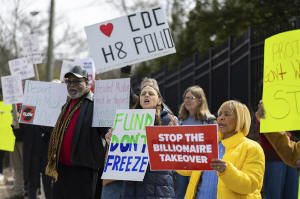Layoffs hit many at CDC lab program that was started to address previous
failures
 Send a link to a friend
Send a link to a friend
 [February 19, 2025]
By MIKE STOBBE [February 19, 2025]
By MIKE STOBBE
NEW YORK (AP) — The nation's top public health agency is losing most of
the scientists in a prestigious, but lesser-known, laboratory program
that has become a mainstay of outbreak responses.
The fellowship program was hit hard during the layoffs coming to many
federal departments, according to five Centers for Disease Control and
Prevention officials who spoke only on condition of anonymity because
they were not authorized to discuss the cuts.
The program had been created about 10 years ago to help the CDC remedy
embarrassing lab-safety failures. The cuts may not have an immediate
impact, but they likely will haunt the nation in the months to come,
said Stephan Monroe, a former CDC official who oversaw the reform of the
agency's lab services.
“The key thing about lab testing is it’s the smoke alarm,” said Monroe,
now retired. “If you can identify those first cases really early, it
allows you to mobilize a big response. ... If they don't know what it is
that’s going on, it could be a lot of transmission started before
response starts.”
With a $9.2 billion core budget, the CDC is charged with protecting
Americans from outbreaks and other public health threats. Before the job
cuts, the agency had about 13,000 employees. They included more than
1,700 scientists working at laboratories — the people who determine or
confirm what germ or other threat is behind a rash of unexplained
illnesses.

Officials at the Department of Health and Human Services have not
provided detail about where cuts were made, and some at the CDC say they
are still sorting out exactly who was cut and which centers or offices
were hit hardest. Some workers at other agencies were told they were
laid off, only to be informed later that they could keep their jobs.
Last week, CDC officials were initially told they were losing nearly
1,300 probationary employees, but the final number was more like 700,
according to two CDC officials who spoke on condition of anonymity
because they were not authorized to discuss the cuts.
On Friday, it appeared the ax was falling on the Epidemic Intelligence
Service, a prestigious two-year program for new disease investigators.
Two agency employees who communicated with EIS staffers, speaking on
condition of anonymity for fear of retribution, told The Associated
Press about the EIS cuts.
[to top of second column]
|

Demonstrators protest Centers for Disease Control and Prevention
(CDC) layoffs in front of the CDC headquarters in Atlanta on
Tuesday, Feb. 18, 2025. (Arvin Temkar/Atlanta Journal-Constitution
via AP)
 But over the weekend, it became
clear that program was spared.
Not so lucky, however, was the Laboratory Leadership Service, a
similar program for lab scientists. At least 16 of the program's 24
fellows were terminated, according to one of the scientists who was
fired.
The leadership program was created in the wake of a series of lab
failures, including an incident in which a CDC lab scientist in
Atlanta accidentally mixed a deadly strain of bird flu with a tamer
strain and another in which a CDC lab failed to kill anthrax samples
before sending them to two labs with fewer safeguards for containing
dangerous germs.
The leadership program brought in doctorate-holding professionals
who could help the CDC and state health labs improve testing while
complying with demanding federal standards. It also was designed to
be a way to recruit top talent to the CDC.
Lab service members often were dispatched to states, territories and
other countries to help identify what was causing an outbreak. They
helped expand testing for dengue when the mosquito-borne disease hit
American Samoa and the U.S. Virgin Islands and rebuilt testing
capability in Puerto Rico after hurricanes. They evaluate new tests
for state health labs, and train staff how to use them.
That kind of expertise is crucial, especially at a time when the
nation is closely watching the spread of a worrisome new form of
bird flu, some experts say.
“Our ability to detect and contain health threats including H5N1 is
already strained. This not the way to make America healthier,”
former CDC director Dr. Tom Frieden wrote on LinkedIn about the lab
program cuts.
All contents © copyright 2025 Associated Press. All rights reserved
 |